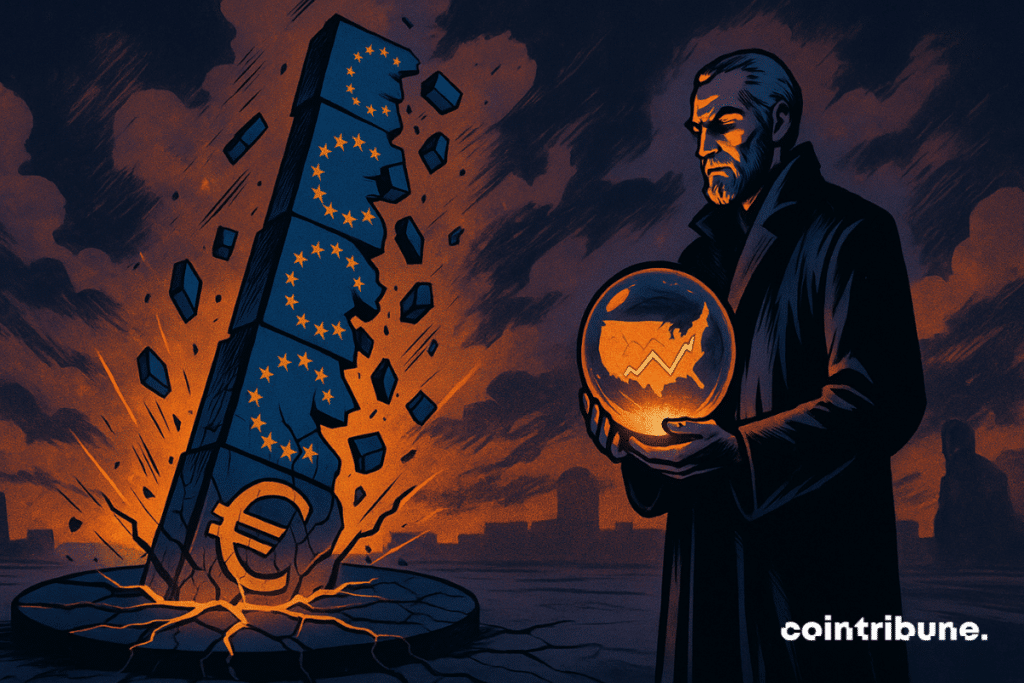8:00 ▪ ▪
5
min at reading ▪
Europe, formerly a pioneer in the regulation of cryptus, could soon be just a simple corridor with crossed innovations without maintaining it. While the United States and Asia multiply concrete advances, the old continent is cautious. Catriona Kellas, the legal director of Franklin Templeton, does not capture the words: the risks of the EU have been included in the rank of viewer, unable to compete in the face of the dynamics of large competing powers.

In short
- Franklin Templeton warns the risk of marginalizing Europe in the global crypto ecosystem that faces the rise of the United States and Asia.
- SIDA regulation, previously perceived as innovative, shows its limits due to the framework considered too strict and slow legislative process.
- Meanwhile, the United States and Asia accept more flexible approaches, attract innovative projects and affect European decisions.
- The position of Europe in global proceedings of crypto is at stake, and its future will depend on its ability to respond quickly and reinforce.
Snída, the leadership has already weakened
While the granting of licenses in Malta is afraid of regulatory bodies, during his intervention in Digiasset 2025 in London from 17 to 18 June, Catriona Kelllas, International Legal Manager for Digital Projects in Franklin Templeton, she expressed clear concerns:
There is a real risk that this technology will escape the courts that were in the foreground a few years ago. It is so easy to delay when the legislative process is too slow.
In spite of the entry into force of the regulation of the element, it draws attention to the possibility that the European Union becomes and “Overview of the area” Between the United States and Asia, the space has crossed, but rarely was elected as a country to welcome the main innovative projects.
And if it recognizes that Europe is still ” in a good position»It points out that this procedure could quickly turn into regulatory inertia.
The alarm signal initiated by Kellas is not only based on pessimistic observation, but is also based on a number of weak institutional signals that show that the EU begins to respond:
- The discussion takes place on mica 2, which is a sign that the limits of the initial framework are already identified;
- The European Commission declared the word “Competition” which means remarkable rupture in the usual discourse, historically more focused on stability than attraction;
- The pilot mode of DLT, which came into force a year ago, is already assessed: According to Kellas, managers are trying to“Renovation to be adapted to its destination”;;
- The European approach remains on the principle of preventive measures, but the gap extends with regions that accept more agile and experimental regulatory frameworks.
These elements show that European institutions are beginning to integrate geopolitical tension around the crypto regulation. However, the pace remains slow in the sector where technological innovations and implant strategies develop much faster than legislators.
United States and Asia in advance
In addition to the strict European framework of Catrion Kellas, it emphasizes offensive dynamics that occurs through the Atlantic and Asia. ”The energy that comes from the United States provides real support to Europe“It underlines the other.
He considers this to be a potential catalyst, but also a latent danger: the vision of the main players in this industry prefers more flexible jurisdictions. While the EU is just looking at possible mica 2, some Asian countries, such as Singapore or South Korea, have already created an agile and experimental environment that are able to seduce innovative societies.
This competitive pressure turns a specific strategy for giants expansion, such as Coinbase and Gemini, in finding the licenses of elevation through Luxembourg and Malta. The aim of these approaches is to use the passport mechanism, which allows you to operate in 27 Member States as soon as the license is obtained in one country.
However, this triggers concerns between some European regulators who are afraid of too rapid consent and heterogeneity of the application of the rules. Kelllas also evokes a global change: ‘We observe that governments challenge their regulatory authorities to be based on traditional formulas».
The composition of global balance appears to occur. If Europe cannot quickly adapt its approach, it can lose its position in international crypts discussions. However, Europe is preparing new regulatory definitions from 2026 because mica is no longer enough.
Maximize your Cointribne experience with our “Read to Earn” program! For each article you read, get points and approach exclusive rewards. Sign up now and start to accumulate benefits.
I graduated from Toulouse and Blockchain Consultant Certification Certification Certification Certification I attached to the adventure of Cointtribuna in 2019. I was convinced of the potential of blockchain to transform many sectors of the economy, and I committed to raising awareness and inform the general public about how the ecosystem took place. My goal is to allow everyone to better understand blockchain and take the opportunity they offer. I try to provide an objective analysis of messages every day, decrypt trends on the market, hand over the latest technological innovations and introduce the economic and social issues of this revolution.
Renunciation
The words and opinions expressed in this article are involved only by their author and should not be considered investment counseling. Do your own research before any investment decision.

